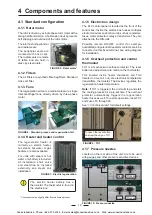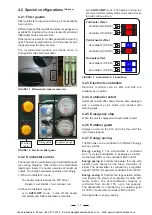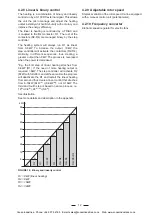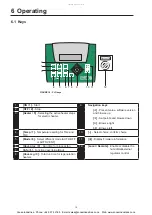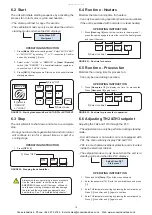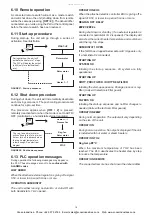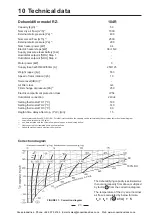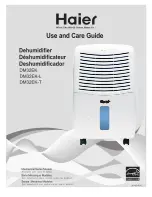
22
Before dismantling the unit, for inspection or service,
the following precautions should be noted:
DST dehumidifiers are designed to run for long periods
with little maintenance requirements. The items listed
below shall however be noted;
9.1 A. Exchanging Filters
The filters should be inspected at regular intervals, the
frequency of which can best be judged by experience.
In storage applications where clean air conditions
normally exist, the filter will typically require changing
only every six months. In process work and dusty
environments, the filter may need to be changed
more often.
A dirty filter will in time affect the drying performance
of the dehumidifier.
9.2 B. General Maintenance
Every two years an inspection of all internal
components of the dehumidifier should be carried out,
the following items being blown with compressed air
and cleaned with a vacuum cleaner.
1. Gear motor and belt transmission.
2. Fans.
3. Electric equipment.
4. Regeneration heater battery.
5. Access doors, hinges, locks and seals.
Depending on how dirty the dehumidifier was at the
first general maintenance, the intervall of inspection
may be increased or decreased.
9.3 C. Washing the Rotor
The SSCR rotor contained in DST dehumidifiers has
a distinct advantage over other types of desiccant
rotors in that dust and grease can be washed out of
the material without any need for reimpregnation after
the treatment.
Before dismantling the unit, for inspection or service,
the following precautions should be noted:
DST dehumidifiers are designed to run for long periods
with little maintenance requirements. The items listed
below shall however be noted;
1. Let the dehumidifier be shut-off for at least an
hour.
2. Carefully remove the rotor from the unit. The
rotor is removed in the following way:
a. Open the lower door s and remove the
transparent polycarbonate access panel,
fixed with screws, from the stainless steel
rotor unit.
b. Remove the rotor motor and the belt tension
device.
c. Loosen the two brackets that are holding
the rotor shaft.
d. Support the rotor with a wooden plank or
similar and push the rotor shaft from the
rotor hub.
e. Carefully roll the rotor out from the unit,
taking great care not to damage the delicate
matrix.
3. Wet the rotor with water and a mild acid based
detergent or with industrial alcohol and allow
to soak for 30 minutes.
4. Rinse carefully with fresh water, pumped at low
pressure through an ordinary hose.
5. Allow the liquid to drain from the rotor structure
and blow the channels free with air. Do not to
hold the air nozzle too close to the rotor surface.
6. Carefully refit the rotor and its transmission belt
into the unit.
7. Ensure that all peripheral and radial seals are
placed correctly.
8. Start the dehumidifier again and let it operate for
one hour without heater before the capacity is
checked. Repeat the washing with a stronger
detergent if the performance has not recovered
satisfactorily.
When dismantling the main switch shall be
turned to "0".
If the unit has been in operation it should
be left to cool off, for at least 30 minutes,
before dismantling.
The wet air duct can be very hot if it is not
insulated.
On no account should the unit be operated
without the correct air filters installed!
Never use a strong alkaline based deter-
gent, as this may destroy the rotor!
9 Maintenance
Cooke Industries - Phone: +64 9 579 2185 Email: sales@cookeindustries.co.nz Web: www.cookeindustries.co.nz



